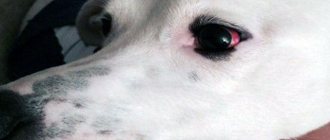Red ears in a dog are not uncommon. The hearing organs of a pet are quite vulnerable. Owners often notice that their pets scratch their ears from the inside. Looking there, you can see redness, and the ears, in most cases, are hot to the touch. It is not always possible to immediately take your dog to a veterinary hospital, so it is advisable to know the reasons for this phenomenon, and also how to provide first aid to your beloved pet.
The dog's ears are red inside and itchy: the main reasons
- Most often, such problems occur in breeds with low-hanging ears. The peculiar structure of the ears closes the internal channels, which prevents proper ventilation. As a result, excessive accumulation of moisture occurs in the narrow passage and creates an environment favorable for the proliferation of fungi and bacteria.
- A common cause of this symptom is water leaking into the ear canal. Rapidly multiplying bacteria lead to inflammation and pain, with redness of the inside of the ear.
- Redness with pronounced borders is characteristic of marks from the bite of a blood-sucking insect or from contact with a poisonous plant. The phenomenon occurs mainly in dogs accompanying their owner on a hunt.
- Pain in the organ of hearing can be caused by the entry of a foreign body, insect, etc. In this situation, the animal behaves restlessly, often scratches its ear, shakes its head, loses sleep and appetite.
Auricular hematoma
Hematoma of the auricle, otherwise called otohematoma, is an accumulation of fluid between the cartilage and skin of the ear. A hematoma occurs due to rupture of blood and/or lymphatic vessels, as a result the ear greatly increases in size.
Symptoms:
- Thickening or swelling of the ear, its drooping, tilting the dog’s head to the side.
— The disease is often accompanied by itching, which can provoke scratching and further trauma to the ear.
Treatment:
1. Apply a pressure bandage for 5-6 days, then open and remove dead tissue.
2. Large wounds are stitched.
3. After the operation, the ears are wrapped around the head and a bandage is applied. For better healing, the bandage is applied with ointments Levomekol, Methyluracil, Solcoseryl.
============================================================================================================================================================================================
Definition of disease
Itching, redness and pain in the ears can accompany diseases such as bacterial otitis, otodectosis, otomycosis, allergic otitis.
Bacterial otitis occurs against the background of inflammation of the middle and outer ear caused by a bacterial infection. Both ears may be affected at once. The reason is a decrease in immunity, leakage of fluid into the ear canal, or a complication after other infectious diseases.
Symptoms observed:
- the auricle is red and hot to the touch;
- neck muscles are tense;
- the animal holds its head to one side;
- The pet does not allow the ear to be examined and shows aggression.
The complication is accompanied by purulent discharge from the ear canal and an increase in body temperature up to 40 °C.
Otodectosis is a common occurrence in young dogs. A parasitic mite that burrows into the ears feeds on the animal's lymph. Usually the insect gnaws the inside of the ear and lays eggs. Then the tick, parasitizing, goes through all stages of development. The causative agent of otodectosis can also affect other parts of the body. Pets can also become infected with otodectosis from cats, birds and other animals.
Symptoms observed:
- itching;
- black discharge;
- smell from the ears.
Advanced otodectosis causes necrosis of the eardrum, which leads to hearing loss. Severe damage provokes the development of meningitis.
Fungal otitis appears after severe illness, taking antibiotics, stress and surgery. The listed reasons cause the proliferation of pathogenic fungi in the ears and manifests itself:
- redness and itching;
- yellowish coating;
- smell of mold.
Allergic otitis may be caused by a reaction to food, hygiene products or veterinary drugs.
Symptoms observed:
- sudden redness of the inner ear;
- swelling and slight rash;
- severe itching.
The more symptoms, the more restless the pet behaves.
Symptoms
Regardless of the cause of swelling of the ear tissue, this problem can be identified by the corresponding signs. An attentive owner will notice the swelling on his own. But you should ask your veterinarian about what to do in this case. Incorrect treatment can harm the animal, because diagnosing the disease without appropriate tests and laboratory tests is very difficult.
Main signs of a problem:
- change in pet's mood;
- the dog's head is constantly tilted to one side;
- the animal presses its ear to its head;
- on the side of the sore ear, the pet’s neck is overstrained;
- the animal sharply turns its head from side to side;
- increased dog anxiety;
- refusal to sleep and eat;
- Purulent discharge with an unpleasant odor may be observed.
If you have several of the above symptoms, you should carefully examine your pet's ears.
How to help
If the ears are affected, the dog should be taken to a veterinarian for examination.
Depending on the causes of redness and itching, treatment is prescribed:
- If water gets in, you need to react immediately. If only a few minutes have passed since the incident, you can solve the problem at home. The pet's head is tilted to the side, leaving the affected ear at the bottom, and they begin to gently shake the head. This will help remove water from the ear canal. Remaining liquid is removed with a sterile cotton swab or a special absorbent ear powder. If difficulties arise during implementation, it is better to contact a veterinarian.
- If a foreign body is stuck, which is visible to the naked eye, the pet can be helped independently. You will need tweezers with rounded tips and a small amount of vegetable oil to process the inside of the ear. After removing the foreign body, the ear is treated with a disinfectant prophylactic agent.
- An insect bite involves a sting left in the wound. After a wasp or bee attack, a thick paste of baking soda and water can easily relieve the itching. You can use a pharmacy antihistamine ointment.
- Otodectosis requires treatment and rinsing of the ear canal to remove black plaque and wax. The procedure must be carried out by a professional. The ear canal is prepared for the procedure, after which drops from otodectosis are instilled into it.
- The veterinarian individually prescribes a treatment regimen, prescribes antifungal ointments, and also prescribes vitamin complexes aimed at strengthening the immune system.
- Bacterial otitis is completely curable with antibiotics. Anti-inflammatory drops will help relieve itching, pain and redness.
- For otomycosis, hydrogen peroxide is used to dilute the exudate in the ear canal, and carefully remove the remains with a cotton swab. All stages of treatment are carried out by specialists. To prevent and prevent relapses, strengthening the immune system is prescribed.
- Allergic otitis media requires elimination of the factor causing the allergy. If the measures taken do not lead to the expected result, then it is better to show the pet to specialists.
Inflammation of the middle ear
The disease often develops as a consequence of untreated otitis media and the transfer of inflammation from the external ear. Or due to a general infectious process (plague). Dogs experience difficulty chewing, swallowing, pain when opening their mouths, and discharge from the nose and eyes. The pet tilts its head towards the sore ear, its temperature rises, and there is no appetite. Complications include meningitis, incoordination of movements, etc.
Treatment is local, removing swelling, inflammation (antiseptics) and general, aimed at eliminating the underlying disease.
Accuracy and prevention
Good hygiene practices are used to reduce the likelihood of developing diseases. Care and constant care of the ear canals will keep the hearing organs in good condition and also prevent the proliferation of pathogenic microflora. It is recommended to purchase sterile cotton wool, sanitary swabs and cotton pads in advance.
Ear care is carried out using prophylactic agents in the form of solutions, lotions, etc. The cleaning liquid is applied to a cotton swab and the inside of the auricle is thoroughly treated. The procedure is carried out regularly, at least 1-2 times a week.
Owners of long-eared dogs must comb out the fur of the ears and remove accumulated dirt, fragments of plants, insects, etc. In addition, representatives of long-haired breeds with hanging ears require regular grooming.
Actions aimed at preventing ear diseases:
- treating wool with preparations against fleas, ticks and other parasites;
- anthelmintic therapy;
- increasing immunity;
- identification of exposure to allergens contained in feed or hygiene products.
After long walks or stay outside the city, a mandatory examination of the pet’s ears is necessary, assessing the cleanliness of the canals and the skin around it. If redness is detected along with itching, pain, the appearance of pus and general anxiety, the dog must be taken to the veterinarian.
First aid at home
If the discharge and inflammation are minor, it is permissible to clean the ear yourself. If there are severe lesions, tumors, or extensive purulent processes, it is almost impossible to treat the ears; the dog will be in pain. Light anesthesia and cleaning in a hospital setting are often required.
Procedure:
- Clean the ear with a special lotion, boric alcohol. You can take sea buckthorn oil or medications for the treatment of otitis media. It is recommended to use hydrogen peroxide (3%) for purulent otitis, just pour it in so that the maximum amount of exudate comes out with foam. But it unnecessarily dries out already inflamed skin.
- Clean out (remove) the exudate well.
- Place Otipax and Otinum drops into the ear and lubricate the entire inner (hanging) surface of the ear with a cotton swab dipped in the drops. The drugs relieve itching, relieve pain, dissolve sulfur and help remove plaque.
Ear cleaning is carried out daily for a week. From the second week you can do the procedure once every 2-3 days. After visiting the veterinarian, all manipulations are done at home as prescribed. If the dog does not allow the breeder to clean its ears, it cannot be left, the help of a doctor will be required. Without removing exudate, the use of drops is not effective.
Fact! In case of purulent and hemorrhagic otitis (when there is blood), cleaning the ears is prohibited!
How often should you visit the veterinarian?
The frequency of visits to the veterinarian should be determined individually, based on the physical condition and age of the dog. There are recommendations for each age, which will be discussed further.
- Dog less than 1 year old: a monthly visit is recommended. It is up to one year that young pets need to have all the necessary vaccinations. The doctor also monitors the development and growth of the dog, whether there are any problems due to a lack of minerals, vitamins, and whether the development corresponds to age. A qualified doctor will definitely draw up a schedule of visits after a thorough examination of your pet. During this period, it is advisable to find a veterinarian who would monitor the dog throughout his life. A kind of family doctor, only for your beloved dog.
- Ages 1-7 years: Recommended annual examination. When the dog is one year old, you need to continue vaccinations according to the previously prescribed veterinary calendar. Don't forget about the annual examination, during which your pet will be thoroughly checked: ears, eyes, nose, heart, lungs, mouth. Only a detailed examination can guarantee the identification of possible symptoms of disease in certain organs. Based on the results of the visit to the veterinarian, recommendations regarding dental care, nutrition, physical activity, etc. will be offered. If there is a suspicion of illness, then additional examinations and tests will be prescribed.
- Ages 8 years and older: Visit your veterinarian every 6 months. Old dogs, like people, are at risk and are more susceptible to various diseases. For this reason, you should visit the veterinarian every six months. In addition to standard examinations, the doctor may prescribe urine, blood, stool tests, x-rays, ultrasound, and blood pressure measurements.
Cases when a trip to the veterinarian should not be postponed
When the dog feels well and no deviations in behavior are observed, it is necessary to visit the veterinarian according to a previously drawn up schedule. However, there are some emergency situations that require emergency assistance from a qualified specialist:
- severe breathing problems are observed;
- the dog was hit by a car;
- the pet does not wake up and is unconscious;
- the dog fell unsuccessfully from a height;
- incessant diarrhea and vomiting throughout the day, pale gums, diarrhea with blood;
- suspected paw fracture or other injury;
- the dog ate something poisonous;
- seizures with convulsions;
- the pet has fallen and does not get up;
- felt a tumor;
- the animal suddenly lost orientation in space;
- the dog whines, hides and trembles;
- other unnatural behavior of the pet.
The dog's ears are red inside and itchy: reasons, what to do
Causes of the problem
The main reasons why a dog may develop allergies include:
- Sensitivity to certain components of dog food (rice, chicken, beef and other products).
- Medications.
- Cosmetics for dog care (shampoo, soap).
- Household chemicals.
- Pollen from indoor and outdoor plants.
- Autoimmune reaction of the body.
As you can see, there are a lot of reasons and figuring out what your dog is allergic to will take a lot of time. In addition, dog owners cannot always compare what causes the onset of an allergy, since the dog’s body does not react to contact with the allergen immediately, but only after a few days. The first signs of an allergy are characterized by the appearance of red spots on the inner surfaces of the ears, and some of them may merge with each other.
A food test will help you understand whether your pet is worried about otitis media or allergies. To carry it out, all potential allergens are consistently excluded from the dog’s diet and the dog is monitored. If the spots on the ears disappear, then it is a food allergy; if not, it is otitis media.
The test should be carried out over a period of approximately 2-3 weeks, and the dog should not be given antihistamines during the entire period. At this time, your pet will feel discomfort, but you will have to be patient, as the test will help you understand what the problem is.
At the veterinary clinic, specialists will conduct a clinical blood test and take a scraping or smear from the ear. Based on the data obtained and information about how the food test went, it will be possible to give an accurate answer as to what disease your pet has and how to treat it.
Appearance of healthy dog ears
To “recognize” the problem when visually examining your pet’s ear, you need to understand what it should be like normally. On the outside, the entire surface of these organs is covered with hair, the density of which should fully correspond to the density of the rest of the hair on the animal’s body. There should be no bald spots or wounds, otherwise you should make sure there are no dermatological problems.
The internal part of the organ often turns out to be much more informative, which is why veterinarians pay increased attention to its assessment. The normal skin color in such areas always remains light pink, without a touch of dirt or any inclusions, with a uniform sparse coat. Inside the ear canals, the presence of a small amount of black, yellow and brown wax is allowed, but if it fills most of the internal space of the organ, this can no longer be considered the norm. Healthy dog ears do not emit an unpleasant odor, and there is no swelling, redness or any unusual discharge on their surface that can cause anxiety to the animal.
Did you know? Dogs' hearing is 10 times sharper than human hearing, so they are able to detect even ultrasounds that are inaccessible to the human ear.
Treatment of otitis media in a veterinary clinic
In the hospital, in-depth treatment of the disease is carried out. The dog is initially examined to determine the causes of the disease, the type, and how long the pathological process has dragged on over time.
Prescribe drugs that stimulate the immune system, clean the ears of exudate, and use antibiotics if necessary. Detoxification is required for chronic otitis media to remove bacterial waste products and tissue breakdown from the body.
Fact! Gentamicin for otitis (instilled) must be used with extreme caution, it causes irreversible hearing loss.
Surgical intervention is indicated for overgrowing of the ear canal and removal of tumors. During the operation, a new ear canal is formed.
Fact! Secondary otitis media cannot be cured without eliminating the underlying disease that triggered the development of the inflammatory process. Using only external preparations to treat the ears will “drive” otitis media into a chronic form that is difficult to treat.
Predisposition of certain breeds to otitis media
Some breeds are more prone to this disease. Most often - dogs with large drooping ears: cocker spaniel, basset hound, dachshund and others. Drooping ears obscure the auditory opening and interfere with “ventilation,” which creates a “paradise” for the reproduction and life of pathogenic microbes.
East European Shepherds also often suffer from this disease. The structure of the ear does not prevent the penetration of dust and microorganisms into it.
Dogs with expressive folds on the muzzle, active swimmers, and those who live in high humidity climates are also at risk.
Diagnostics
During the examination, the doctor visually assesses the signs of otitis in the dog: the condition of the ears, nasopharynx, mouth and eyes. At the same time, asking questions about feeding, vaccinations and existing pathologies.
Be sure to have scrapings, ear discharge and blood tested. Laboratory tests will show the number of bacteria and parasites and determine their adaptability to medications. They will also determine your general condition and the possibility of allergies.
In some cases, radiography is used. This happens if the research is not informative enough. It shows the presence or absence of tumors and polyps in the nasopharynx. It is also possible to conduct a CT or MRI to exclude the possibility of brain inflammation. Some manipulations can be performed under general anesthesia.
Therapy is prescribed only based on test results. A specialist should tell you how to cure otitis media in a dog. Otherwise, the treatment will not bring results and will worsen the situation.











